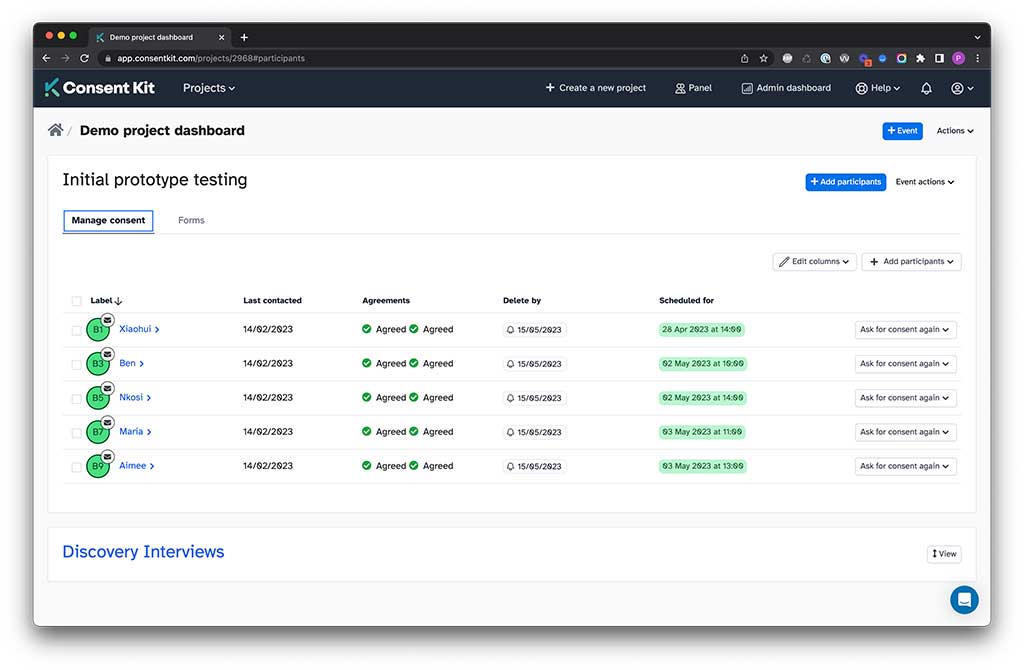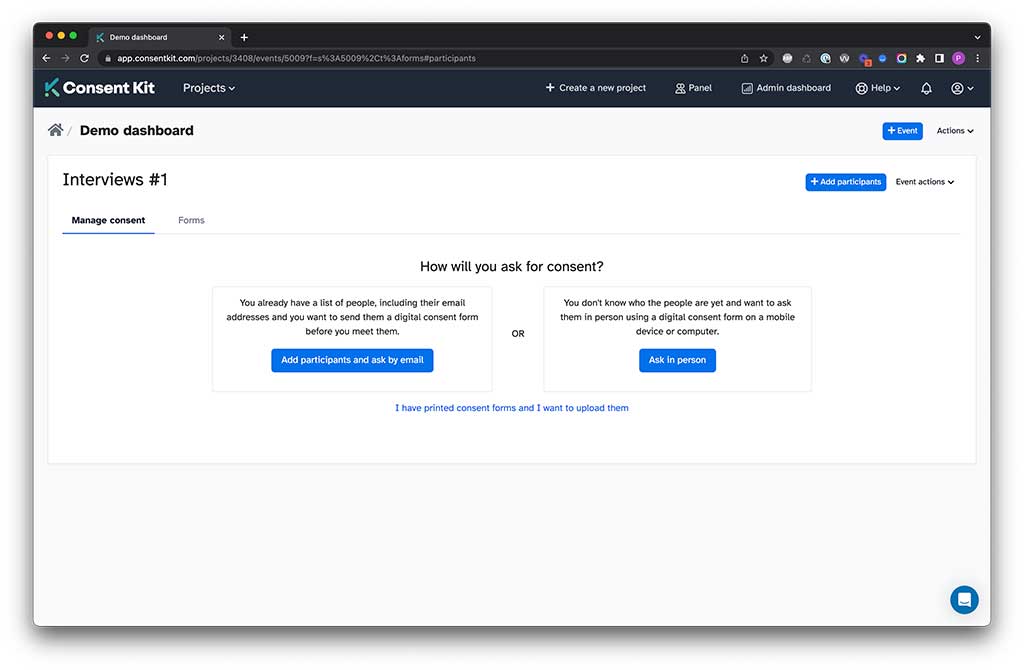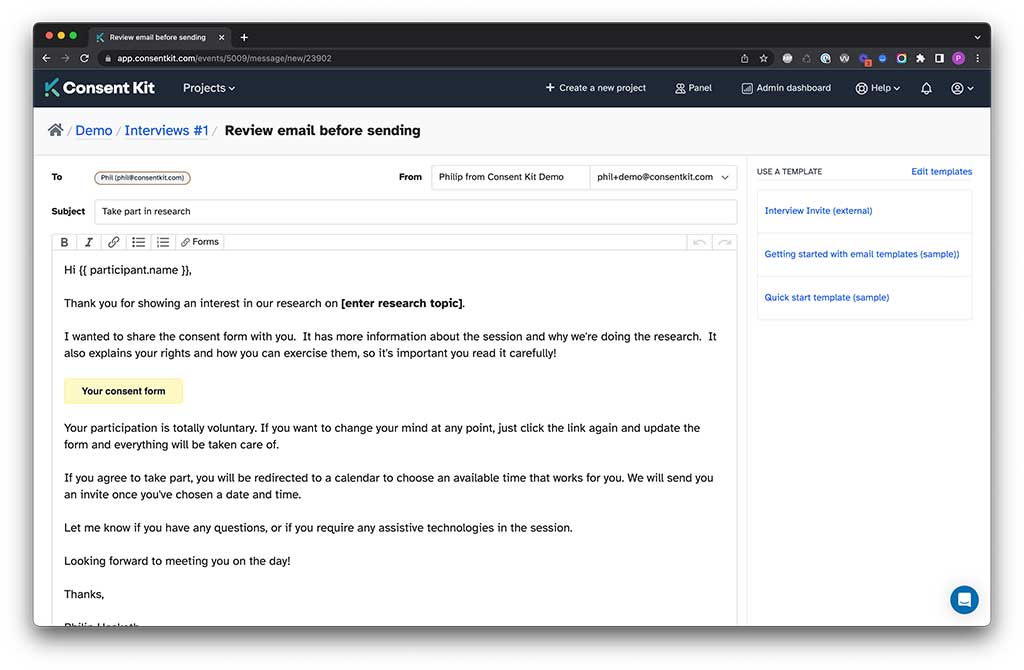Research Ops & Tools
What is a User Research CRM

Written by: Phil Hesketh
Published on:
The amount of admin work that goes on before you get to the actual research is a lot.
Before your research even begins, you have to find and screen participants, manage their incentives, collect consent, schedule user interviews and sessions, and do so much more.
Without it, research doesn’t happen. You didn’t go into research to deal with a mountain of paperwork. And yet, with so many low value, repetitive admin tasks, it’s a big part of the job.
Well, that’s where user research CRM comes in.
Having a CRM doesn’t reduce the amount of admin that needs to be done. But it can automate and streamline many of them. So, you can spend far less time and effort on admin, and focus on the work that matters - Your research projects.
In this guide, you’ll learn all about user research CRMs. We’ll discuss:
What is a CRM built specifically for managing user research projects
What makes it such an invaluable tool for researchers
The benefits of implementing a user research CRM into your workflow
We’ll also talk about the difference having a CRM will make to your projects
Finally, we’ll also show you the key features of a good user research CRM platform.
It’s quite a lot to cover so, let’s get right into it.
What is a user research CRM?
I know - Research isn’t the first thing we associate with a CRM tool. For most people, CRM is something a sales team would use. Some might associate it with hiring and HR.
But research? No, not really.
And yet, when you think about it, us researchers use similar processes to sales and other professions when it comes to dealing with other people.
Our goals and objectives are different, of course. But we both:
Look for people who match specific profiles. Sales is building lists of leads. We build research panels
We reach out to those people. Sales conducts outreach. We try to involve more participants in research studies.
And most importantly, we manage and handle their data. We keep track of engagement history, past research projects, and so on.
Naturally, I’m not saying that sales and research are similar. But you have to agree that the way we manage and process participant information isn’t much different from how other industries do it.
And hence the need for a CRM in research projects too.
User research CRM is a software that helps researchers manage various interactions with research participants. And that includes everything from screening and recruiting target users to panel management, data management and governance to everything in between.
The role of CRM in research projects
In the section above, we talked about the purpose of a user research CRM - To help manage and streamline various interactions with research participants.
But what does that really mean in a typical research project?
Typically, a CRM would help research teams manage these aspects of the entire research process:
Participant recruitment including participant outreach
Screening potential participants
Creating, sending, and managing consent forms
Getting documents signed electronically (and storing data about it)
Scheduling user interviews or usability tests
Managing and distributing incentives
Data management and audit trails, and more.
In other words, the CRM exists to reduce your admin workload and lets you focus on the actual research.
Here’s an example of what a user research CRM looks like. Quick disclaimer - This is a dashboard of our tool, ConstentKit. You can learn more about it here.

But why invest time and effort into implementing a research CRM?
Fair question. Introducing a new tool into your tool stack will require effort, time, training, and perhaps even rethinking your existing processes…But it’s well worth it. And I’ll show you why in two ways.
In this section, I’m going to outline what benefits research teams enjoy after having implemented a user research CRM.
Then, in the subsequent section, I’ll compare what life looks like with and without such a tool.
So, let’s start with the benefits.
First of all, a research CRM will significantly reduce the time you spend on administrative tasks. In fact, customers using our tool - ConsentKit - regularly report saving up to 45 minutes per participant.
As one of our customers, Vimla Appadoo, told us:
“Consent Kit was a life saver in speeding up the process and giving the team the confidence that we were ticking all the boxes we needed to, to make our participants feel safe and secure.”
(You can read Vimla’s full case study here.)
The CRM will also reduce cognitive effort and enable you to focus on higher value tasks. This happens because the tool can streamline low value tasks, or even automate quite a lot of them, freeing the time you’d normally spend on them for other work.
User research CRM boosts data governance. With the CRM, you’ll always know where the data is. You’ll also be able to collect informed consent, give participants meaningful information about the research and control over what you record during research sessions, and how you use their data, and more.
With CRM you can manage participants better. You can clearly see who has been involved in what research and where their information is.
Overall, a CRM will speed up your research, and that’s for several reasons:
Such a tool will make it easier for you to build research panels. You’ll have access to a database of participants whom you’ve already identified, screened, and in many cases, have worked with before.
With CRM, you’ll save a ton of time on repetitive tasks, meaning that you can get to the research part of the project much faster.
You’ll also experience fewer issues across the entire project, and reduce potential bottlenecks.
But let’s look at this in more detail…
This is how you conduct user research without a CRM
Short version: It’s all about spreadsheets, Google Forms or other survey tools, and email.
It doesn’t matter whether you have a dedicated tool to manage participant interactions or not, you still have to do it. Which, in a situation where you manage a research project without a CRM, means doing all this work manually.
You set up different spreadsheet documents to add participant information to and track their status.
You build consent forms with Google or MS Forms (or another survey tool) and manually copy and paste responses to a relevant spreadsheet.
You send emails with different times for sessions, and endure long back and forth with each participant until you two agree on a date,
You copy and paste those times into a relevant spreadsheet too
Then you email participants again to discuss incentives, and as I’m sure you’ve guessed by now, copy and paste their responses to a spreadsheet.
You then update the spreadsheet when you’ve distributed those incentives, send a ton of follow-up emails, and also, continuously try to reconcile information from emails with relevant participant data in excel…
I don’t even know where to begin outlining problems with this system. Well, maybe I’ll start here - Such a laborious and tedious manual process doesn’t offer any quick view of potential participants and responses.
In fact, the only way to gain such insights is to continuously reconcile information from those disjointed sources into relevant spreadsheets, and that just means even more admin work.
Unfortunately, that presents another problem - Doing the admin manually also means that it’s incredibly easy to forget about tasks, leaving gaps in your workflow.
Here’s what the same process looks like with the CRM
Short version: With a CRM, the manual process above turns into an efficient and formalised one that also supports multiple ways of working (i.e., remote, in-person, and via third-parties.)
With a CRM, you create a new study within the CRM, including any documents you need (i.e., consent forms and NDAs.) The CRM, most likely, already includes templates for those, and you can always edit and create custom templates of those to get this part done fast.

Then, you add the people you want to learn from to your study, using your existing database of participants, or by importing a list from your third party recruiter.

You invite those people to take part in your project by sending them the documents you need signed and a link to your scheduling calendar.

Here’s where working with user research CRM gets really exciting…
Your study is automatically updated when people sign documents or schedule a time, or collect their incentives so you can see exactly where everything is up to at a glance.
You don’t have to do anything about those tasks, as the CRM automates all those activities by default.
But the CRM offers additional benefits to your workflow:
In the CRM, you can specify an organisation-wide cooldown period on participation. This way, you won’t end up over utilising people and burning them out by inviting them to too much research too quickly.
Because the admin is automated, your data collection is more consistent at scale. This makes streamlining enabling people’s rights, such as the right to withdraw, to access their information or to have it deleted much easier without having to enforce policies and constantly train people.
The CRM itself can onboard people and is easier to follow than a manual process. So scaling your process and onboarding new people from your organisation, contractors or agencies is a lot simpler.
How ConsentKit research CRM helps manage and scale research projects?
Consent Kit (disclaimer - this is our tool) is a CRM that gives Research Ops a hassle-free and scalable approach to inclusive participant management.
Designed for privacy first. Consent Kit de-risks data governance while making teams more efficient. Saving 45 mins per participant in admin time.
Here’s what makes ConsentKit one of the best CRMs for managing user research projects:
Centralised document management generate project specific documents in a few clicks, from pre-approved templates (that work a bit like Lego)
Access control to projects and studies. Only you, your administrator and whoever you invite to collaborate have access to the data.
Research recruitment. With Consent Kit you can add people from your research panel, upload an email list, add them one at a time, share a link to your documents or ask people in person. No matter how you’re recruiting, your process is resilient enough to support it.
Document level workflows. With ConsentKit, you can send an email to participants with one button. Once the participant has signed the first document, Consent Kit will automatically send them the next one. Or forward them onto your scheduling calendar. Or send them to an unmoderated study.
Integrations with your other tools. Eg: sync Consent Kit to your calendar. If someone withdraws before the session, your calendar updates automatically.
All documents and forms are accessible. Accessible to WCAG 2.1AA. ConsentKit enables participants to navigate consent and your recruitment process in other languages, if English isn’t their first language.
Participants have complete autonomy over their data
. Subject Access Requests and withdrawals from research processes are built in.
Wondering how much easier would it be to manage research projects with a dedicated CRM? Sign up for a free trial and take ConsentKit for a test drive.
Psst! Don’t feel confident setting everything up yourself? Book a demo instead and we’ll walk you through the ins and outs of our user research CRM.



